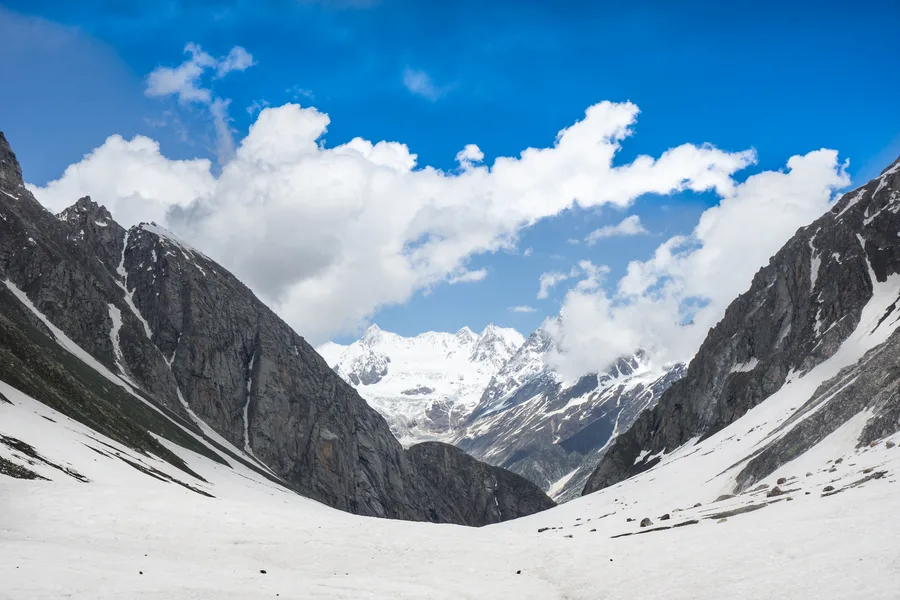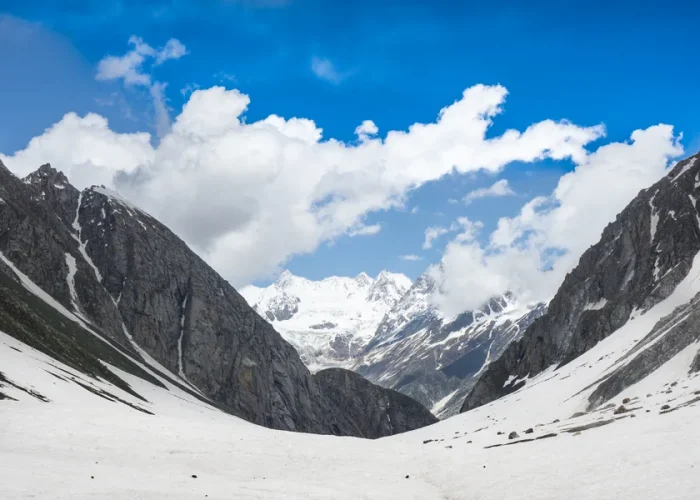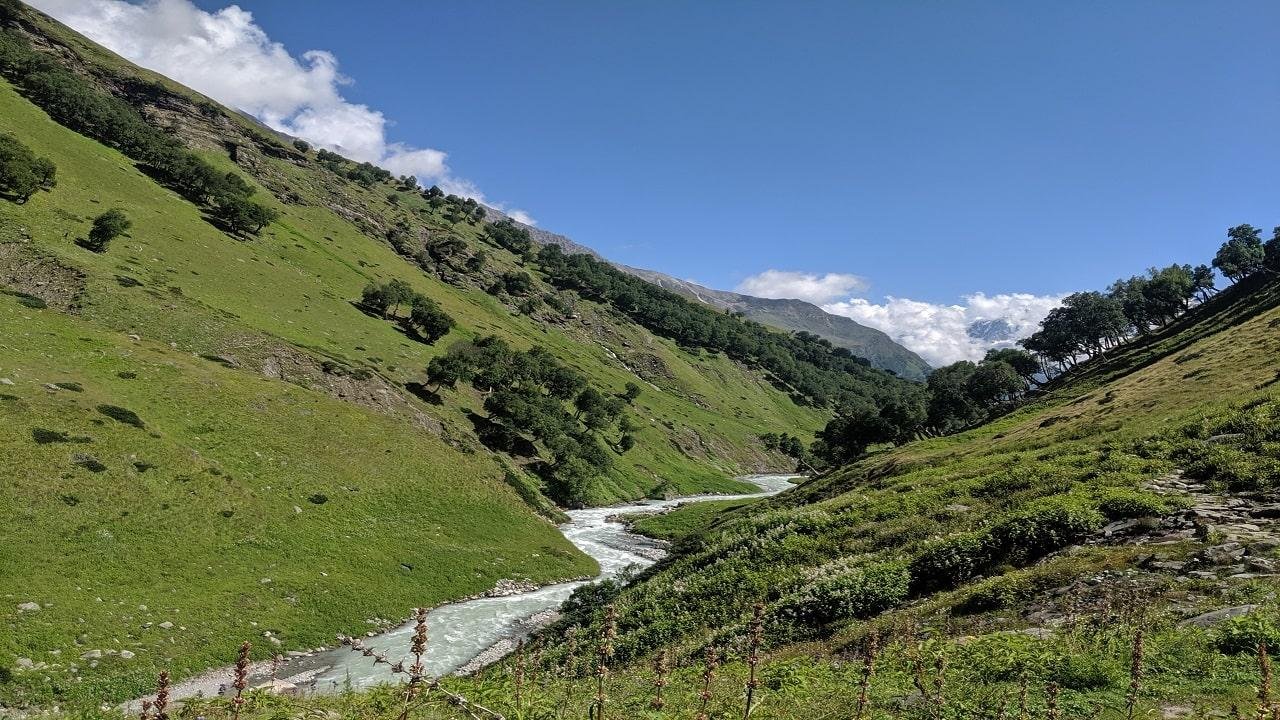
Lamkhaga Pass trek
+5% GST
On Request

Stay

Taxi

Meals

Guide

Camping
Uttarakhand to Himachal
10 days
Difficult
68 km
May June Oct
17330 ft.

Lamkhaga Pass trek
+5% GST
On Request

Stay

Taxi

Meals

Guide

Camping
Uttarakhand to Himachal
10 days
Difficult
68 km
May June Oct
17330 ft.
About Lamkhaga Pass
- Region : Uttarakhand
- Duration :10 days
- Base Camp : Harsil
- Nearest airport : Dehradun
- Pickup Point : Dehradun, Haridwar
- Drop Point : Chitkul

Located at a height of more than 17000 feet, the Lamkhaga Pass trek is considered the high-altitude trek in Garhwal Himalayas. During the Lamkhaga Pass trek, you will get the golden opportunity to explore even the remote areas of Himachal Pradesh and Uttrakhand which will leave you stunned.
The trek is so beautiful, picturesque, and delightful that you will wonder whether these places are real. The Lamkhaga Pass trek is also bordered by numerous mountains. However, get ready to fall in love with the beauty of nature and you will feel like never coming back.
You can do this Lamkhaga Pass trek during the summer and autumn seasons. The eye-catching meadows, glorious waterfalls, garrulous streams as well and lush forest will make your trip memorable. Though, Lamkhaga Pass trek is a difficult trek in Uttarakhand Himalayas because of its remoteness and altitude but will surely give you an electrifying and breathtaking experience.
FIX DEPARTURE
1st, 2nd, 3rd, 4th, 5th, 6th, 7th, 8th, 9th, 10th, 11th, 12th, 13th, 14th, 15th, 16th, 17th, 18th, 19th, 20th, 21st, 22nd, 23rd, 24th, 25th, 26th, 27th, 28th, 29th, 30th, 31st May.
1st, 2nd, 3rd, 4th, 5th, 6th, 7th, 8th, 9th, 10th, 11th, 12th, 13th, 14th, 15th, 16th, 17th, 18th, 19th, 20th, 21st, 22nd, 23rd, 24th, 25th, 26th, 27th, 28th, 29th, 30th June.
1st, 2nd, 3rd, 4th, 5th, 6th, 7th, 8th, 9th, 10th, 11th, 12th, 13th, 14th, 15th, 16th, 17th, 18th, 19th, 20th, 21st, 22nd, 23rd, 24th, 25th, 26th, 27th, 28th, 29th, 30th, 31st Oct.
FAQs
The Lamkhaga Pass Trek is an adventurous high-altitude trekking route that connects the Indian state of Uttarakhand with Himachal Pradesh, offering stunning views of the Himalayas and challenging terrain.
The Lamkhaga Pass Trek typically spans around 10 days, covering a distance of approximately 68 kilometers round trip, depending on the chosen itinerary and pace of the trek.
The highest point reached during the Lamkhaga Pass Trek is the Lamkhaga Pass itself, which stands at an altitude of approximately 5,282 meters (17,323 feet) above sea level, offering panoramic views of the surrounding peaks.
The best time to embark on the Lamkhaga Pass Trek is typically from May to June and September to Mid October, during the summer and early autumn months when the weather is favorable, and the trekking trails are accessible.
Yes, permits are required for the Lamkhaga Pass Trek as it passes through protected areas and forest reserves. Trekkers need to obtain permits from the forest department or authorized agencies before commencing the trek.
Challenges during the Lamkhaga Pass Trek include Altitude sickness, long trekking, steep ascents and descents, crossing snowfields and glaciers, navigating through rugged terrain and rocky trails, and adapting to high-altitude conditions. Trekkers should be well-prepared both physically and mentally to tackle these challenges.
Yes, prior trekking experience is highly recommended for the Lamkhaga Pass Trek, as it is a demanding trek that requires good physical fitness, endurance, and experience in high-altitude trekking.
Essential items to pack for the Lamkhaga Pass Trek include appropriate clothing for varying weather conditions, sturdy trekking boots, technical equipment, trekking poles, water bottle, first aid kit, sunscreen, and personal medications. Additionally, carrying high-energy snacks and a headlamp is advisable.
Yes, camping is allowed during the Lamkhaga Pass Trek, and there are designated camping areas along the route where trekkers can pitch their tents and spend the night amidst the pristine Himalayan wilderness.
Emergency services such as medical assistance and rescue operations may be available in nearby towns or villages along the Lamkhaga Pass Trek route. However, trekkers are advised to carry a comprehensive first aid kit and have contingency plans in place for emergencies.
The Lamkhaga Pass Trek typically starts from the village of Harsil in Uttarakhand and ends at Chitkul in Himachal Pradesh, offering a thrilling journey through some of the most remote and scenic regions of the Indian Himalayas.
Lamkhaga Pass Trek (Detailed Itinerary)
Drive 221km/9-10 hrs
Harsil is 221km away from Dehradun so we will start our drive in the morning to reach Harsil by the evening. In the route, you will come across beautiful views.
After having breakfast, we will start the trek for Laldevta camp which is 7km from Harsil. Make sure that you carry your camera because you will come across picturesque sights that are sure to amaze you.
Get up early in the morning to experience the breathtaking sunrise. We will trek through a dense forest of oak as well as rhododendron. Beside the Kyarkoti Lake, your night stay will be scheduled in camps which will give you amazing vistas of nature.
Have your delicious breakfast and get ready for the trekking to Lamkhaga Base Camp which is 12km away from Kyarkoti. In order to reach Lamkhaga Base Camp, we will go through a narrow valley via Sukha Tal. The night stay will be scheduled in tents.
On day 05, you will relax at Lamkhaga Base Camp. Enjoy the amazing views of nature which will make you fall in love with its extraordinary beauty.
Leave the base camp in the morning and start trekking to Gundar via Lamkhaga Pass which is located at an altitude of 5282m. Today the trekking will be a bit difficult because you will trek through the rocky path.
Get up early in the morning and after having breakfast start trekking to Dumti which is located at a height of 4035m. You will also get tempting and attention-grabbing views of Himalayan peaks which will leave you stunned.
While trekking to Rani Kanda, you will have wonderful vistas of nature. Get ready to have astonishing sights of the Himalayan landscape along with lush green meadows as well as gushing river streams.
After having tasty breakfast, get ready for the trekking to Chitkul which is a beautiful village in Himachal Pradesh, and is famous for its striking beauty. You will also come across beautiful vistas of nature that are worth capturing.
Say goodbye to the memorable trek trip. We will be reaching Shimla by evening so plan accordingly.
FIX DEPARTURE
1st, 2nd, 3rd, 4th, 5th, 6th, 7th, 8th, 9th, 10th, 11th, 12th, 13th, 14th, 15th, 16th, 17th, 18th, 19th, 20th, 21st, 22nd, 23rd, 24th, 25th, 26th, 27th, 28th, 29th, 30th, 31st May.
1st, 2nd, 3rd, 4th, 5th, 6th, 7th, 8th, 9th, 10th, 11th, 12th, 13th, 14th, 15th, 16th, 17th, 18th, 19th, 20th, 21st, 22nd, 23rd, 24th, 25th, 26th, 27th, 28th, 29th, 30th June.
1st, 2nd, 3rd, 4th, 5th, 6th, 7th, 8th, 9th, 10th, 11th, 12th, 13th, 14th, 15th, 16th, 17th, 18th, 19th, 20th, 21st, 22nd, 23rd, 24th, 25th, 26th, 27th, 28th, 29th, 30th, 31st Oct.
THINGS TO CARRY
BASIC GEARS
- Backpack & Rain Cover (50-70 Litres)
- Hiking bag (20 litre)
- Trekking Shoes (Ankle Shoes)
- Warm clothes
- Water Bottles
CLOTHES
- Jacket (Down or padded)
- Fleece or woolen clothes
- Trek pants and Trousers
- T-shirts (collar and full sleeves)
- Thermal inner wears (both upper and lower)
- Woolen or Fleece cap
- Hand Gloves
- Socks (4 pairs)
- Neck cover, Muffler, Balaclava, any
ACCESSORIES
- Sunglasses
- Sunscreeen Lotion (SPF 50/70)
- Moisturizer and Lip Balm
- Sun cap
- Raincoat and Ponchos
- Power banks
- Trekking pole
- Headlight
OTHERS
- Small Hiking bag (10-20litre) (for summit climb or if you opt to offload your backpack)
- Tiffin box
- Flip flops
- Glucose, Dry fruits
- Personal Toiletries kit
- Toilet paper roll and sanitizer
- Personal basic medical kit
MANDATORY DOCUMENTS
- Original with photocopy of government photo identity card any one (Passport, Aadhaar Card, Driving license or Voter ID)
Inclusions
- Meals : All Meals as per menu from first day Dinner to last day Breakfast at basecamp; Vegetarian Meal.
- Accommodation (Hotel, Homestay, Camping)
- Camping charges : Camping and forest permit fees for Indian Nationals.
- Trekking equipment : High quality tents (living tent- triple sharing, kitchen tent, dinning tent, toilet tent)
Exclusions
- Meals during road journeys
- Insurance
- Any personal expenses
- Transportation
- Mules or porter to carry personal luggage
- Anything apart from inclusions
Backpack Offloading Charges
• Offload your backpack to a mule or porter to lighten your load during the trek.
• Offloading charges range from ₹300 to ₹900 per day per bag, depending on the specific trek.
• Ensure your backpack weighs less than 11 kg and is equipped with a waterproof cover.
• Suitcases, trolleys, or duffel bags are not allowed.
POLICY
Booking Confirmation Policy
• The customer receives a Booking confirmation receipt immediately via Email and WhatsApp of a successful booking.
Cancellation policy
In the event you cancel your trek, cancellation policy we follow :
• Cancellation 20 days before the starting date of the trek – Refund with 10% cancellation charges.
• Cancellation 10 days before the starting date of the trek – Refund with 50% cancellation charges
• Cancellation less than 10 days from the starting date of the trek – No refund
Note: HA gives you a facility in the event of cancellation due to some reason to transfer your trek (same trek and same batch) to your friend.
REFUND :
• The refund will be given in the form of a trek voucher with 1 year validity, you will get an email for your trek voucher, which will take up to 7 working days.
FAQs
The Lamkhaga Pass Trek is an adventurous high-altitude trekking route that connects the Indian state of Uttarakhand with Himachal Pradesh, offering stunning views of the Himalayas and challenging terrain.
The Lamkhaga Pass Trek typically spans around 10 days, covering a distance of approximately 68 kilometers round trip, depending on the chosen itinerary and pace of the trek.
The highest point reached during the Lamkhaga Pass Trek is the Lamkhaga Pass itself, which stands at an altitude of approximately 5,282 meters (17,323 feet) above sea level, offering panoramic views of the surrounding peaks.
The best time to embark on the Lamkhaga Pass Trek is typically from May to June and September to Mid October, during the summer and early autumn months when the weather is favorable, and the trekking trails are accessible.
Yes, permits are required for the Lamkhaga Pass Trek as it passes through protected areas and forest reserves. Trekkers need to obtain permits from the forest department or authorized agencies before commencing the trek.
Challenges during the Lamkhaga Pass Trek include Altitude sickness, long trekking, steep ascents and descents, crossing snowfields and glaciers, navigating through rugged terrain and rocky trails, and adapting to high-altitude conditions. Trekkers should be well-prepared both physically and mentally to tackle these challenges.
Yes, prior trekking experience is highly recommended for the Lamkhaga Pass Trek, as it is a demanding trek that requires good physical fitness, endurance, and experience in high-altitude trekking.
Essential items to pack for the Lamkhaga Pass Trek include appropriate clothing for varying weather conditions, sturdy trekking boots, technical equipment, trekking poles, water bottle, first aid kit, sunscreen, and personal medications. Additionally, carrying high-energy snacks and a headlamp is advisable.
Yes, camping is allowed during the Lamkhaga Pass Trek, and there are designated camping areas along the route where trekkers can pitch their tents and spend the night amidst the pristine Himalayan wilderness.
Emergency services such as medical assistance and rescue operations may be available in nearby towns or villages along the Lamkhaga Pass Trek route. However, trekkers are advised to carry a comprehensive first aid kit and have contingency plans in place for emergencies.
The Lamkhaga Pass Trek typically starts from the village of Harsil in Uttarakhand and ends at Chitkul in Himachal Pradesh, offering a thrilling journey through some of the most remote and scenic regions of the Indian Himalayas.

